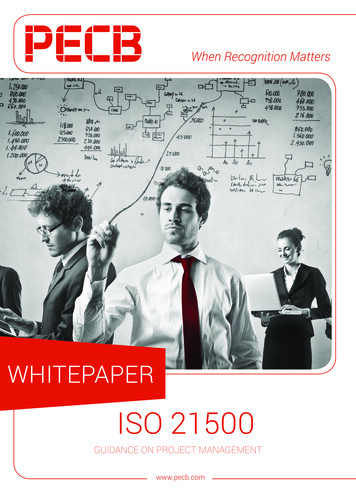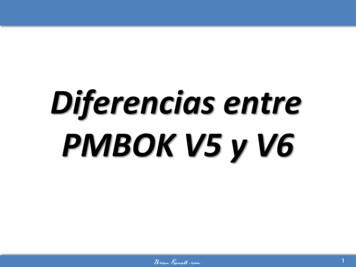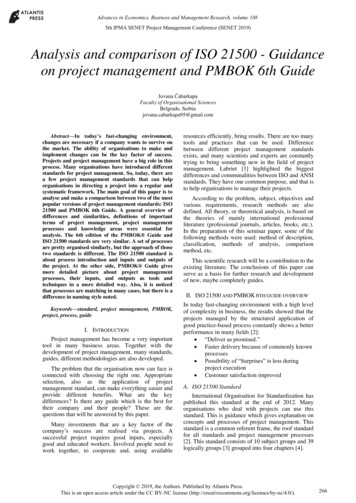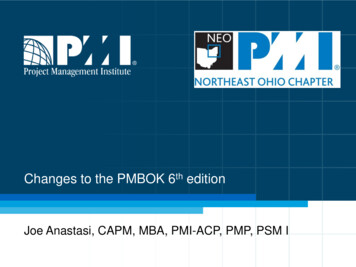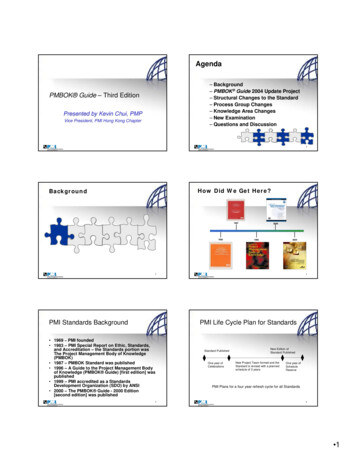
Transcription
ISO 21500:2012 and PMBoK 5 processes inInformation Systems Project ManagementJoão Varajão, Ricardo Colomo-Palacios, Hélio SilvaAbstractThe purpose of this research is to contribute to a better understanding of information systems (IS) projectmanagement practice, by investigating the ISO 21500:2012/PMBoK 5 processes implemented by projectmanagers in this kind of projects. Responses to an international web-based survey, representing 472projects in total, showed that processes from knowledge areas as, for instance, scope management, costmanagement, and time management, are frequently implemented. However, there are processes fromimportant areas as, for instance, quality management and risk management, that are being relegated to asecond plane, what is a matter of concerning. Since IS projects do not have a very good reputationconcerning success, these results can be of outmost importance to help researchers and practitioners toimprove project management performance.KeywordsInformation Systems; Information Technology; Projects; Project Management; Practice; Processes;Standards.1. IntroductionA process can be defined as a “set of interrelated or interacting activities, which transforms inputs intooutputs” (ISO 2008). In the past decades many guides of good practices, comprising processes andtechniques, have been developed, covering all aspects of managing projects from their initiation to theirclosing (White and Fortune 2002).Nevertheless, Project Management (PM) remains a highly problematical endeavor. Projects still fail to liveup to the expectations of stakeholders as they continue to be disappointed by projects’ results (CookeDavies 2002; Dai and Wells 2004; Whitty 2005; Standish Group 2011; Fernandes 2013). In the particularcase of information systems (IS), the projects continue to show lower levels of success (Colomo-Palacioset al., 2014a; Liberato et al. 2015; Ribeiro et al. 2013; Rijo et al. 2012; Varajão et al. 2014; Varajão et al.2014) due to several reasons (Cerpa and Verner 2009): project underestimates; inadequate requirementswhen the delivery decision is made; changes in scope; risks not re-assessed, controlled, or managedthrough the project; unrealistic expectations; inappropriate methodology; etc.A common feature of failed projects is the lack of effective project management (Applegate et al. 1996;Langer et al. 2008). The proper implementation of PM processes best practices should improve PMperformance, thus resulting in improving the speed and quality, fewer mistakes, lower cost because ofless rework, fewer delays and snags, better use of time, and customer satisfaction (Milosevic andPatanakul 2005).Several guides can be used by organizations in selecting the most appropriate processes and techniquesto improve PM in a given context, being ISO 21500:2012 and PMBOK good examples of standards. ISO21500:2012 provides guidance for project management and can be used by any type of organization,including public, private or community organizations, and for any type of project, irrespective ofcomplexity, size or duration (ISO 2012). ISO 21500:2012 is aligned with PMBOK 5. PMBOK 5 (A Guide tothe Project Management Body of Knowledge – Fifth Edition) provides guidelines for managing individualprojects and defines project management related concepts. It also describes the project management lifecycle and its related processes, as well as the project life cycle (PMI 2013).1
On one hand, it has been recognized over the last decades that project management is an efficient tool tohandle novel or complex activities (Munns and Bjeirmi 1996). On the other hand, practice shows that ISprojects continue to not achieve the most desirable results (Varajão et al. 2014). So, it is important toinvestigate to what extend the PM standards are actually used, to identify opportunities of improvement.As we can observe in the literature, there is only limited evidence on the standards implementation in PMpractice, being the research of Papke-Shields et al. (2010) one of the few available studies, however it isnot focused in the particular case of IS projects. Other efforts include partial implementations like the oneprovided in the work of Yan et al. (2013), which pictures an effort to combine ABC analysis with PMstandards or efforts conducted in the field of, for instance, risk analysis (Kutsch, Denyer, Hall and LeeKelley 2013; Marcelino-Sádaba et al., 2014).The purpose of this paper is to identify which ISO 21500:2012 and PMBoK 5 processes are beingimplemented in IS projects. Our study, part of a wider international study seeking to characterize severaldimensions of IS projects success, complements existing research by providing a richer understanding ofIS project management practice.This research addresses the gap in the literature by examining the following research questions:1) Are the ISO 21500:2012 and PMBoK 5 processes being implemented in IS project management?2) Are the project management standards (ISO) and Bodies of Knowledge suitable to characterize the ISproject management processes?To answer these questions, we conducted an international survey with 107 experienced IS projectmanagers. We asked each of them to identify the frequency of implementation of a list of processes in thelast projects they participated.This paper is organized as follows. The following section summarizes the relevant literature on projectmanagement processes. The research design and methodology are described next. Then, the keyfindings and results are presented. This is followed by the discussion of results. Finally, we conclude withimplications from this study for practice and research and some highlights for further research.2. Background2.1. Information SystemsInformation Systems (IS) play an extremely important role in modern organizations, since they arepresent in almost every aspect of business (Varajão et al. 2009a; Varajão et al. 2009b). IS are nowadaysa business core asset, essential to improve productivity (Varajão et al. 2009a), reduce operational costs,improve the managerial decision making, and gain competitive advantages, just to mention a fewbenefits.In a rapidly changing business and technological environment, the ability to develop and deploy newsystems is an important asset that can differentiate one organization from another (Patnayakuni andRuppel 2010). Moreover, organizations must continuously innovate in terms of product, process, marketand business model in order to remain sustainable (O’Sullivan and Dooley 2010). The sustainablesuccess of any organization is strongly associated with the success of the IS projects (Colomo-Palacioset al. 2014a). However, the success of IS projects is far from the desirable and the establishment ofeffective and efficient project management practices still remains a challenge (Liberato et al. 2015).Companies currently use multiple IS solutions to support their activities at all management levels and fewof them try to conduct their businesses without seeking to exploit the advantages of IS. Due to theincreasing complexity of organizations, the projects are also becoming more complex (Lucio-Nieto et al.2012; Varajão and Cruz-Cunha 2013) and currently an IS project can assume many sizes and forms,including ERP (Enterprise Resource Planning system) implementation, CRM (Customer RelationshipManagement system) implementation, SCM (Supply Chain Management system) implementation, BI(Business Intelligence system) implementation, ERP module implementation, custom systemimplementation, systems improvement, process improvement using information technology, systemsmigration, infrastructure enhancement, consultancy, and others. The development/implementation type2
can also vary, from customized development up to COTS (Customer of the Shelf)/packaged softwareimplementation (or both).2.2. Project Management Bodies of KnowledgeA PM body of knowledge is the sum of knowledge within the profession of PM. The complete PM Body ofKnowledge includes proven traditional practices that are widely applied, as well as innovative practicesthat are emerging in the profession (Sydow et al. 2004). The attempts by the Bodies of Knowledge tosystematize the knowledge required to manage projects are largely based on the underlying assumptionthat there are identifiable patterns and generalizations, from which rules, controls and guidelines for bestpractice can be established that are replicable, even if not on absolutely every circumstance (Martinsuo etal. 2006). PM Bodies of Knowledge have been published by the professional PM associations in the lastdecades. There has been an emergence of multiple Bodies of Knowledge, such as: PMBOK from ProjectManagement Institute (Morris 1997); APM BOK from Association for Project Management (Thomas andMullaly 2007); ICB from International Project Management Association (Morris et al. 2006); and P2M fromProject Management Association of Japan (Thomas & Mullaly 2008). These Bodies of Knowledge areused by practitioners as ‘Best Practice’ guides to what the discipline comprises (Shi 2011). The PMBoK ,APM BOK and P2M are of the most influential publications on what constitutes the knowledge base of theprofession (White & Fortune 2002). The research is progressing in order to find if the PM practices aredependent on the organizational context (e.g. industry, size, project type and geographic location)(Fernandes 2013).2.3. PMBoK 5 and ISO 21500:2012The PMBOK contains the globally recognized standard and guide for the project management profession.A standard is a formal document that describes established norms, methods, processes, and practices.As with other professions, the knowledge contained in this standard has evolved from the recognizedgood practices of project management practitioners who have contributed to the development of thisstandard (PMI 2013).PMBOK 5 has the following process groups: initiating; planning; executing; monitoring and controlling;and closing. It identifies 10 “knowledge areas” for organizing processes: integration; stakeholder; scope;human resources; time; cost; risk; quality; procurement; and communication. ISO 21500:2012 is basedand aligned with PMBOK.ISO (the International Organization for Standardization) is a worldwide federation of national standardsbodies (ISO member bodies). The work of preparing International Standards is normally carried outthrough ISO technical committees. Each member body interested in a subject for which a technicalcommittee has been established has the right to be represented on that committee. Internationalorganizations, governmental and non-governmental, in liaison with ISO, also take part in the work. ISOcollaborates closely with the International Electrotechnical Commission (IEC) on all matters ofelectrotechnical standardization. International Standards are drafted in accordance with the rules given inthe ISO/IEC Directives (ISO 2012).ISO 21500:2012 provides guidance on concepts and processes of project management that are importantfor, and have impact on, the performance of projects. It provides high-level description of concepts andprocesses that are considered to form good practice in project management. Projects are placed in thecontext of programmes and project portfolios, however, this International Standard does not providedetailed guidance on the management of programmes and project portfolios. Topics pertaining to generalmanagement are addressed only within the context of project management (ISO 2012).ISO 21500:2012 identifies the following process groups: initiating; planning; implementing; controlling;and closing. It also identifies 10 “subjects” for organizing processes: integration; stakeholder; scope;resource; time; cost; risk; quality; procurement; and communication.The differences between ISO 21500:2012 and PMBOK 5 are minimal concerning the process groups andsubjects/knowledge areas. The main difference is in the description of tools and techniques, because ISO21500:2012 do not provide it.3
3. MethodOur method involved a web-based survey of information systems project managers. The data wasanalyzed using descriptive statistics and reliability estimates. This approach was chosen because thestudy of project management processes is well enough advanced that a qualitative approach wasdeemed unnecessary and because others (v.g. (ISO 2012; PMI 2013)) have already identified acomprehensive list of general processes that can be used as a basis to study the information systemsproject management.3.1. Measurement InstrumentBased on ISO 21500:2012 (ISO 2012), on PMBOK 5th edition (PMI 2013), and on the literature review, asurvey instrument was used to measure the implementation of information systems project managementprocesses. The questionnaire contained a list of forty seven processes (as presented in Table 1, column2), organized in ten knowledge areas (integration, scope, time, cost, quality, human resource,communications, risk, procurement, stakeholder). All of the items used a Likert scale (“Never”,“Occasionally”, “Often”, “Always”), concerning the frequency of implementation in practice. It was used thenomenclature proposed by (PMI 2013), since the processes of ISO 21500:2012 and PMBOK are quitesimilar, and PMBOK has a more detailed list of processes. As can be seen in Table 1, many processeshave the same names in ISO 21500:2012 and in PMBOK 5 (e.g., “Develop Project charter” (ISO 2012)and “Develop Project Charter” (PMI 2013)); others have different names but are similar (e.g., “Controlchanges” (ISO 2012) and “Perform integrated Change Control” (PMI 2013)); and others are grouped(e.g., the process “Administer contracts” (ISO 2012) is related to the processes “Control procurements”(PMI 2013) and “Close procurements” (PMI 2013)). The data was collected at organizational level.Table 1. Project Management processesISO 21500:2012 (ISO 2012)PMBOK 5 (PMI 2013)Integration (IM):Develop Project CharterDevelop project plansDirect project workControl project workControl changesClose project phase or projectCollect lessons learned (related to “close project orphase” in PMBOK)Integration (IM):IM: Develop Project CharterIM: Develop project management planIM: Direct and manage project workIM: Monitor and control project workIM: Perform integrated Change ControlIM: Close project or phaseScope:Scope (SM):SM: Plan Scope managementSM: Collect requirementsSM: Define scopeSM: Create WBS (Work Breakdown Structure)Define scope (related to “collect requirements” and“define scope” in PMBOK)Create Work Breakdown StructureDefine activities (related to “define activities” of “time”in PMBOK)Control scopeTime:Sequence activitiesSM: Validate scopeSM: Control scopeTime (TM):TM: Plan Schedule managementTM: Define activities (related to “define activities” of“scope”)TM: Sequence activitiesTM: Estimate activity resources (related to “estimateresources” of “resources”)4
Estimate activity durationsDevelop scheduleControl scheduleTM: Estimate activity durationTM: Develop scheduleTM: Control scheduleCost:Cost (CM):CM: Plan Cost managementCM: Estimate costsCM: Determine budgetCM: Control costsEstimate costsDevelop budgetControl costsResource:Establish project teamEstimate resources (related to “estimate activityresources” of “time” in PMBOK)Define project organization (related to “plan humanresource management” in PMBOK)Develop project teamControl resources (related to “monitor and controlproject work” of “integration” in PMBOK)Manage project teamHuman Resources (HRM):HRM: Plan Human Resource managementHRM: Acquire project teamHRM: Develop project teamHRM: Manage project teamQuality:Plan qualityPerform quality assurancePerform quality controlQuality (QM):QM: Plan Quality managementQM: Perform quality assuranceQM: Control qualityRisk:Risk (RM):RM: Plan Risk managementRM: Identify risksRM: Perform qualitative risk analysisRM: Perform quantitative risk analysisIdentify risksAssess risk (related to “perform qualitative riskanalysis” and “perform quantitative risk analysis” inPMBOK)Treat risksControl risksStakeholder:Identify stakeholdersManage stakeholdersRM: Plan risk responsesRM: Control risksStakeholder (StM):StM: Identify stakeholdersStM: Plan stakeholders managementStM: Manage stakeholders engagementStM: Control stakeholders engagementCommunication:Plan CommunicationsDistribute informationManage communicationsCommunication (CmM):CmM: Plan Communications managementCmM: Manage communicationsCmM: Control communicationsProcurement:Plan procurementsSelect suppliersAdminister contracts (related to “control procurements”and “close procurements” in PMBOK)Procurement (PM):PM: Plan Procurement managementPM: Conduct procurementsPM: Control procurementsPM: Close procurementsAlthough our study used items identical to those in PMBoK 5 (PMI 2013), thus taking advantage ofprevious validation, the context validity of the questionnaire was examined prior to starting of the survey.Two professors of IS and project management and nine IS project managers pilot-tested the surveys. Theresults indicated a few minor refinements that were made to the final questionnaire.5
3.2. Data CollectionOur sample of IS project managers was primarily drawn from the worldwide community of LinkedIn users.A discussion topic with a link to the online survey was posted in several groups of project managementand IS. In addition, it were sent initial and follow-up emails to project managers and chief informationofficers, with information about the survey and a link to the survey. The data was collected fromNovember 2014 to January 2015. In total, 111 surveys were obtained. Since four of the surveys wereunusable due to incomplete responses, a final number of 107 complete surveys, representing 472projects in total, were used in our analysis, yielding a total of 96.4% valid responses.Table 2 summarize the demographics of participating project managers. The respondents consistedmainly of project managers (52.3%) and chief information officers (19.7%). With respect to age, themajority has more than 40 years old (71.1%). Regarding years in project management the majority hasmore than 10 years of experience (58%) and 18.7% has more than 20 years of experience. Finally,93.5% of the respondents indicated that they held graduate or postgraduate degrees.Table 2. Profile of respondent project managersFrequencyPercentMale8579.4Female2220.627 – 403229.941 – 504844.9 e6056.1Informatics2018.7Information Systems3936.5Business t manager5652.3CIO / IT Director2119.7Director / Manager1514.0Other1514.01 – 102321.511 – 204542.1GenderAgeEducationEducation areaTraining or certification in project managementCurrent positionAverage years in position6
203936.41–51312.16 – 103229.911 – 204239.3 202018.7 112523.411 – 304239.2 304037.4Average years in project managementNumber of projects as project managerTable 3 summarizes the characteristics of the respondents’ companies. Respondents came fromorganizations of varying sizes (small, medium and large). Many of the companies have their PMmethodology aligned with PMBoK (37.4%) and only 12.1% uses a PM maturity model to improve their PMpractices. The sample is split evenly in several of the contextual variables (e.g., total employees andturnover), which renders the analysis more reliable. The majority of companies have headquarters inEurope (62.6%) and North America (23.4%), and international presence (60.7%).To sum up, the respondents are experienced project managers, representing a variety of company sizesand project management approaches.Table 3. Profile of respondents’ companiesFrequencyPercent1 – 2003330.8201 – 5002018.7501 – 20002220.6 20003028.0Do not know / Do not answer21.9 1.000.0001514.01.000.000 – 10.000.0001917.810.000.001 – 250.000.0002422.4 250.000.0002321.5Do not know / Do not answer2624.3North America2523.4Europe6762.6Other1514.014239.32 – 103633.6 102927.1Total employeesTurnoverHeadquartersNumber of countries where is present7
CertificationsYes5046.7No5753.3PMBoK or Custom (based on PMBoK)4037.4Custom (based on various methodologies)2624.3It is not used a formal methodology2220.5Other1917.8Yes1312.1No9487.9MS Project5551.4MS Excel2018.7Custom1312.1Other1917.8Project management approach/methodologyUses a project management maturity modelMain software used in project management4. Results and discussionCronbach’s Alpha was computed to test the reliability and internal consistency of the responses.Cronbach’s Alpha is .967 (47 items), which is considered excellent (Cohen 1988), indicating a highdegree of internal consistency in the responses.Answering to the research question (“Are the ISO 21500:2012 and PMBoK 5 processes beingimplemented in IS project management?”), Figure 1 shows the computed ranking of IS projectmanagement processes. Results show that our population implement all the processes at leastoccasionally and do not proposed new processes, enabling to answer positively to the research question“Are the project management standards (ISO) and Bodies of Knowledge suitable to characterize the ISproject management processes?”.All processes have averages between 1.6 and 2.6 in a scale of 0 (meaning “never”) to 3 (meaning“always”). The processes overall average is 2.2 (2 means “Often”). The top 5 most frequentlyimplemented processes in IS project management are “CM: Determine budget”, “TM: Develop schedule”,“SM: Define scope”, “SM: Collect requirements” and “TM: Define activities”. Whereas the 5 lessimplemented ones, with averages equal or lower than 1.8, are “RM: Perform quantitative risk analysis”,“RM: Plan Risk management”, “IM: Develop Project Charter”, “RM: Perform qualitative risk analysis” and“RM: Plan risk responses”.The fact that all the processes proposed by ISO 21500:2012/PMBOK 5 are being put in practice by ISproject managers is particularly interesting, since more than an half of the survey’s participating projectmanagers do not have a certification in PM (53.3%) and they are not using ISO 21500:2012/PMBOK asthe main PM approach/methodology (62.6%). Also to note that according to Müller and Turner (2007),certified project managers perform better on high performing projects (but not for all kind of projects).Given that IS projects are normally high performing projects, the difference in the view of the project,project management, its results and insights, seem to be important in the case of IS project managers. Toinvestigate whether project managers who have specialized training in project management and thosethat do not have it differ on the implementation of project management processes, it were used MannWhitney tests. Although the importance of certification for the community is still moderate (Catanio,Armstrong and Tucker 2013; Stevenson and Starkweather 2010), it was found a significant difference (p 0.05) in the case of the processes: IM: Develop project management plan (p 0.12); SM: Create WBS(p 0.001); TM: Define activities (p 0.35); TM: Estimate activity resources (p 0.31); TM: Estimate activityduration (p 0.32).8
Figure 1. Ranking of IS Project Management Processes9
Considering the ranking position of the processes from primary knowledge areas such as scopemanagement, time management, and cost management, there are not reasons for concern in theseprocesses, since all, without exception, are between the “often” and “always” levels of implementation.Notwithstanding the focus on these processes, the results of cost, scope and time compliance in ISprojects are not very positive. For instance, delays are very common in IS projects (Varajão et al. 2014).So, we can conclude that the processes from time, cost and scope management are of course veryimportant, but they are not sufficient to guarantee the time, cost and scope compliance in projects.Processes from other areas, although not being considered primary, are of central importance for PMperformance.Looking at the processes at the bottom of the ranking, we find, for instance, many processes from qualitymanagement (considered also a primary area) and from risk management. Quality Management includesthe processes and activities of the performing organization that determine quality policies, objectives, andresponsibilities so that the project will satisfy the needs for which it was undertaken. Works to ensure thatthe project requirements, including product requirements, are met and validated (PMI 2013). RiskManagement comprises the processes of conducting risk management planning, identification, analysis,response planning, and controlling risk on a project. The objectives of project risk management are toincrease the likelihood and impact of positive events, and decrease the likelihood and impact of negativeevents in the project (PMI 2013). From these definitions, it become clear that these are important areas ofPM and the low usage of these processes can be a strong reason for the chronic problems in IS projects.To mention the particular case of risk management processes, since results show that these processesare well below the recommendable levels of usage, what is a matter of concerning.Risk management in IS project is a hot topic in recent literature. Several meta-analysis depict the need ofsuch management (Aloini, Dulmin and Mininno 2007; de Bakker, Boonstra and Wortmann 2010),although, according to these studies there is not still enough empirical evidence to pair risk managementand project success. More focused studies like, for instance, of Jun et al. (2011), lead to some positiveevidences, limited in this case to the vendor side. In the paper by Kutsch and Hall (2009), some of the ofthe reasons behind this pale adoption can be found. These authors underline that, in one-third of cases,because of the problem of cost justification, no formal project risk management process was applied.Following this anti-pattern approach, Kutsch et al. (2013) dig deeper into these reasons and stablishsome of the reasons behind this disengagement: managers sometimes see risks as fictional pieces ofmanagement. In our study the reasons for a poor risk management in IS projects were not explored,being this an opportunity for future research.To investigate if there was a significant association between the demographic variables of projectmanagers and their companies, it were done several statistical tests. In the major case of variables werenot found relevant associations. The exception were the variables project manager age (and experiencein project management) and PM methodology, since were found associations between all the riskmanagement processes and these variables.Correlations were computed using the Spearman rho statistic, to investigate if there was a statisticallysignificant association between the age of the project manager and implementation of projectmanagement process. It were found positive correlations between the age of the project manager and theprocesses: RM: Plan Risk management (rho .215, p 0.05); RM: Identify risks (rho .247, p 0.05); RM:Perform qualitative risk analysis (rho .338, p 0.05); RM: Perform quantitative risk analysis (rho .272,p 0.05); RM: Plan risk responses (rho .245, p 0.05); RM: Control risks (rho .234, p 0.05).We used nonparametric Kruskal-Wallis tests to compare the four levels of project managementmethodology on the dependent variables implementation of project management processes. It was founda significant difference (p 0.05) in the case of the processes: RM: Plan Risk management (p 0.002); RM:Identify risks (p 0.012); RM: Perform qualitative risk analysis (p 0.041); RM: Perform quantitative riskanalysis (p 0.042); RM: Plan risk responses (p 0.012); RM: Control risks (p 0.024).Considering the obtained results, we can conclude that both the project manager’s age (and experience)and the adopted project management approach/methodology influence the implementation of processesof risk management; this must be taken on account when structuring the project management team. Inother words, an experienced project manager seems to be more aware of the importance of the risk10
management processes, what can be of major importance for the success of the project, particularly inthe case of more complex projects.5. ConclusionThere is no doubt that information systems are the backbone of today’s organizations (Muhic andJohansson 2014; Carriço et al. 2014), being present in almost every aspect of business (Varajão et al.2009b; Varajão et al. 2009c). Nevertheless its importance, the IS projects continue to show lower levelsof success (Rijo et al. 2012; Liberato et al. 2015; Varajão et al. 2014; Ribeiro et al. 2013; Varajão et al.2014).PM standards are important tools to improve PM performance (Papke-Shields et al. 2010), however, untilnow, there is only very limited evidence on the extent of standards usage. This paper contributes to theliterature with new insights on the IS PM practice.The results of our international web-based survey, showed that, on one hand, processes from knowledgeareas as, for instance, scope management, cost management, and time management, are oftenimplemented. Nine processes from these areas are in the top 10 of the most implement processes: “CM:Determine budget”; “TM: Develop schedule”; “SM: Define scope”; “SM: Collect requirements”; “TM: Defineactivities”; “CM: Estimate costs”; “TM: Estimate activity duration”; “TM: Sequence activities”; and “CM:Control costs”. The only exception in the top 10 is the process “IM: Monitor and control project work”, fromintegration management, which is transversal to all the knowledge areas and occupies the 10th position inthe ranking. On the other hand, there are processes from other important areas as, for instance, qualityand risk management, that are being relegated to a second plane, what is a matter of great concern andcan be in the root of many problems of this kind of projects.
2.3. PMBoK 5 and ISO 21500:2012 The PMBOK contains the globally recognized standard and guide for the project management profession. A standard is a formal document that describes established norms, methods, processes, and practices. As with other professions, the knowledge contained in this standard has evolved from the recognized
